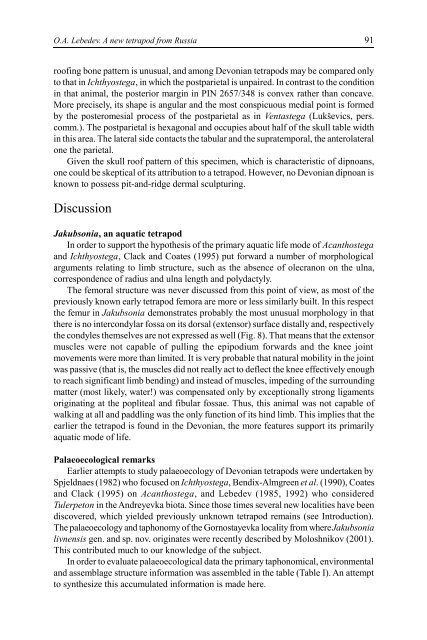Zemes un vides zinātnes Earth and Environment Sciences - Latvijas ...
Zemes un vides zinātnes Earth and Environment Sciences - Latvijas ...
Zemes un vides zinātnes Earth and Environment Sciences - Latvijas ...
You also want an ePaper? Increase the reach of your titles
YUMPU automatically turns print PDFs into web optimized ePapers that Google loves.
O.A. Lebedev. A new tetrapod from Russia<br />
91<br />
roofing bone pattern is <strong>un</strong>usual, <strong>and</strong> among Devonian tetrapods may be compared only<br />
to that in Ichthyostega, in which the postparietal is <strong>un</strong>paired. In contrast to the condition<br />
in that animal, the posterior margin in PIN 2657/348 is convex rather than concave.<br />
More precisely, its shape is angular <strong>and</strong> the most conspicuous medial point is formed<br />
by the posteromesial process of the postparietal as in Ventastega (Lukševics, pers.<br />
comm.). The postparietal is hexagonal <strong>and</strong> occupies about half of the skull table width<br />
in this area. The lateral side contacts the tabular <strong>and</strong> the supratemporal, the anterolateral<br />
one the parietal.<br />
Given the skull roof pattern of this specimen, which is characteristic of dipnoans,<br />
one could be skeptical of its attribution to a tetrapod. However, no Devonian dipnoan is<br />
known to possess pit-<strong>and</strong>-ridge dermal sculpturing.<br />
Discussion<br />
Jakubsonia, an aquatic tetrapod<br />
In order to support the hypothesis of the primary aquatic life mode of Acanthostega<br />
<strong>and</strong> Ichthyostega, Clack <strong>and</strong> Coates (1995) put forward a number of morphological<br />
arguments relating to limb structure, such as the absence of olecranon on the ulna,<br />
correspondence of radius <strong>and</strong> ulna length <strong>and</strong> polydactyly.<br />
The femoral structure was never discussed from this point of view, as most of the<br />
previously known early tetrapod femora are more or less similarly built. In this respect<br />
the femur in Jakubsonia demonstrates probably the most <strong>un</strong>usual morphology in that<br />
there is no intercondylar fossa on its dorsal (extensor) surface distally <strong>and</strong>, respectively<br />
the condyles themselves are not expressed as well (Fig. 8). That means that the extensor<br />
muscles were not capable of pulling the epipodium forwards <strong>and</strong> the knee joint<br />
movements were more than limited. It is very probable that natural mobility in the joint<br />
was passive (that is, the muscles did not really act to deflect the knee effectively enough<br />
to reach significant limb bending) <strong>and</strong> instead of muscles, impeding of the surro<strong>un</strong>ding<br />
matter (most likely, water!) was compensated only by exceptionally strong ligaments<br />
originating at the popliteal <strong>and</strong> fibular fossae. Thus, this animal was not capable of<br />
walking at all <strong>and</strong> paddling was the only f<strong>un</strong>ction of its hind limb. This implies that the<br />
earlier the tetrapod is fo<strong>un</strong>d in the Devonian, the more features support its primarily<br />
aquatic mode of life.<br />
Palaeoecological remarks<br />
Earlier attempts to study palaeoecology of Devonian tetrapods were <strong>un</strong>dertaken by<br />
Spjeldnaes (1982) who focused on Ichthyostega, Bendix-Almgreen et al. (1990), Coates<br />
<strong>and</strong> Clack (1995) on Acanthostega, <strong>and</strong> Lebedev (1985, 1992) who considered<br />
Tulerpeton in the Andreyevka biota. Since those times several new localities have been<br />
discovered, which yielded previously <strong>un</strong>known tetrapod remains (see Introduction).<br />
The palaeoecology <strong>and</strong> taphonomy of the Gornostayevka locality from where Jakubsonia<br />
livnensis gen. <strong>and</strong> sp. nov. originates were recently described by Moloshnikov (2001).<br />
This contributed much to our knowledge of the subject.<br />
In order to evaluate palaeoecological data the primary taphonomical, environmental<br />
<strong>and</strong> assemblage structure information was assembled in the table (Table I). An attempt<br />
to synthesize this accumulated information is made here.
















